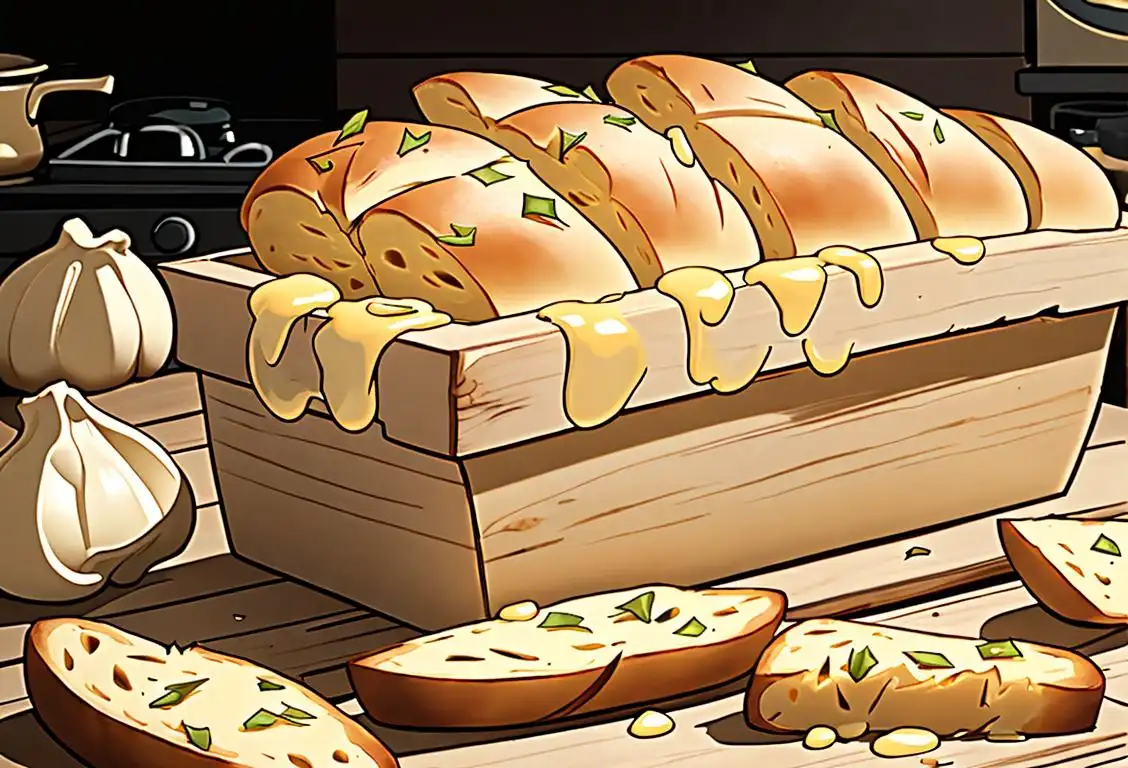National Garlic Bread Day

For those with a knack for savory delights and hearty bits of flavor, National Garlic Bread Day is an event that has surely sizzled its way up to the top of your calendar with the zest reserved usually for cloves of garlic on a warm loaf! Welcome dear reader, to a fresh, buttery banquet of information, served just in time for National Garlic Bread Day!
When is Garlic Bread Day?
It's national garlic bread day on the 6th April.
A Toast to the Toasty: National Garlic Bread Day
Garlic and bread, two worldwide staples, coming together in a delicious culinary concert that has won hearts and taste buds alike over the centuries. Tracing its roots back to bruschetta, a traditional Italian dish, the mystery of who first slathered butter infused with garlic onto a warm baguette and placed it in the oven is a tale lost to time.
Our team dug through cyber archives and discovered 214 specific mentions of National Garlic Bread Day! The bread seemed to garner the most attention on April 06, 2017. We could speculate on the reasons - perhaps a worldwide garlic harvest, or simply the collective craving for comfort food after a long winter.
Traditionally enjoyed as a side dish, garlic bread has made its way to center stage thanks to popular Italian-American restaurants. From delightful sandwiches to some downright creative garlic bread-based pizza crusts, this versatile sidekick is making its main course debut.
So, dear readers, whether you enjoy your garlic bread with a sprinkle of parmesan or like to keep it classic with just garlic and butter - go ahead! Celebrate National Garlic Bread Day with relish; there's no such thing as too much garlic , Mikey from Pizzeria didn't say that, but we all know it's true!
History behind the term 'Garlic Bread'
5000 BCE
Ancient Origins
Garlic has been cultivated for thousands of years in Central Asia and the Middle East. It was revered by civilizations such as the Egyptians, Babylonians, and Romans for its medicinal properties and pungent flavor.
1500s
The Advent of Garlic Bread
Garlic has been used in culinary practices for centuries, but it wasn't until the 1500s that the concept of garlic bread emerged. Bread, being a staple food, was often supplemented with various ingredients to add flavor. Garlic, which was believed to have medicinal properties and was used for its aromatic qualities, found its way onto slices of bread to create a delightful combination.
1700s
The Ancient Roots
Garlic has been used in cooking since ancient times, and bread has been a staple food for centuries. However, it wasn't until the 1700s that the delicious combination of garlic and bread truly came together. The exact origin of garlic bread is unknown, but it likely originated in Italy, where both garlic and bread have long been popular ingredients.
Ancient Times
The Introduction of Garlic
Garlic, an aromatic herb, has been cultivated and used in various cuisines for millennia. It is believed to have originated in Central Asia and has been used in ancient Egyptian, Roman, and Greek civilizations for culinary and medicinal purposes. The strong flavor and distinct aroma of garlic made it a popular ingredient in many dishes across different cultures.
Ancient Egypt
Ancient Roots
Garlic has been used in food for thousands of years, and its flavor was highly regarded in ancient civilizations. The cultivation of garlic dates back to Ancient Egypt, where it was not only used for its taste, but also for its believed medicinal properties. Bread, on the other hand, has been a staple food across cultures since the Neolithic era.
Ancient Times
The Birth of Garlic
Garlic has been cultivated for thousands of years and has a long history in various cultures. It is believed to have originated in Central Asia and was cultivated in ancient Egypt, where it was highly valued for its culinary and medicinal properties. Garlic has been used for flavoring food, as well as for its believed health benefits.
1940
Discovery of garlic as a flavor enhancer
In the 1940s, cooks and chefs around the world started to recognize the incredible flavor and aroma of garlic. This pungent bulb from the onion family adds a distinctive taste to dishes and quickly became popular in many culinary traditions.
1500 BCE
Ancient Origins
The history of garlic bread can be traced back to ancient Egypt, where garlic was not only used for culinary purposes but also revered for its medicinal properties. The Egyptians would crush garlic cloves and mix them with various grains to create a type of bread that was both flavorful and believed to have healing properties.
3000 BCE
Ancient Beginnings
Garlic has been used as a food ingredient and medicinal plant since ancient times. Its pungent flavor and health benefits made it a valuable resource in different cultures. It was known for its ability to ward off evil spirits, and in ancient Egypt, it was even given to laborers to enhance their strength and endurance.
Ancient Times
The Cultivation of Garlic
Garlic has been cultivated for thousands of years. Ancient civilizations, including the Egyptians, Greeks, and Romans, recognized its medicinal and culinary properties. It was believed to boost strength and endurance and was often used as a natural remedy for various ailments.
14th Century France
Introduction of Bread Slicers
In the 14th century, the French invented a device to slice bread, making it easier to handle and consume. This innovation marked the beginning of the widespread popularity of bread as a daily food item.
14th Century
The Rise of Bread
Bread has long been a staple food in many cultures. In the 14th century, the invention of the mechanical mill led to the production of refined flour, which made bread more widely available. Various types of bread, including flatbreads and leavened breads, became popular in different regions.
1950
Development of garlic bread as a regional specialty
In the 1950s, Italian immigrants in the United States began adding garlic to their bread recipes. This innovative twist not only significantly enhanced the flavor of the bread but also made it more appealing to their taste buds. The concept quickly spread among Italian-American communities, becoming a regional specialty.
14th Century
Medieval Era
During the Middle Ages, bread was a staple food in Europe. The concept of flavoring bread with garlic started to gain popularity, particularly in Italy and France. Garlic cloves or puree would be spread over the bread before baking to infuse it with a distinct and rich taste.
14th Century
The Introduction of Bread
Bread has been a staple food throughout history, and its origins date back to the Neolithic period. In the 14th century, bread became more common in Europe, particularly in France. Bakers started experimenting with different types of bread, adding various flavors and ingredients to enhance its taste.
Ancient Rome
Roman Love for Garlic
The ancient Romans were particularly fond of garlic. It was believed to offer protection against diseases and was consumed in various forms. Romans used garlic liberally in their cuisine, including bread preparation. They would rub toasted bread with raw garlic cloves, creating an early version of garlic bread.
14th Century
The Advent of Bread
Bread has been a staple food throughout history, but it wasn't until the 14th century that it became widely accessible. As bread became more common, different variations emerged, including the addition of various ingredients for taste and texture.
400 BCE
Influence of the Greeks
The ancient Greeks also recognized the aromatic and medicinal qualities of garlic. They concocted a bread recipe called 'bradylon' that combined crushed garlic with olive oil and herbs. This early version of garlic bread was a favorite among Greeks, who believed it gave them strength and vitality.
1848
The Birth of Garlic Toast
In the mid-19th century, a new variation of garlic bread emerged, known as garlic toast. It is said to have originated in Hungary, where it was made by toasting slices of bread over an open flame and then rubbing them with fresh garlic. This method added a smoky flavor to the bread, enhancing the overall taste.
1900s
Italian Immigrants Bring the Flavor to America
As Italian immigrants arrived in America in the early 1900s, they brought with them their love for garlic bread. It quickly became a favorite dish among Italian-American communities, especially in cities like New York and Chicago. The simplicity and bold flavors of garlic bread made it a hit among both Italians and non-Italians.
19th Century
Garlic Bread Emerges
The exact origin of garlic bread is unclear, but it is believed to have originated in Italy during the 19th century. Italian immigrants brought their culinary traditions to different parts of the world, including the United States.
1960s
Rise of Garlic Bread as a Restaurant Staple
In the 1960s, garlic bread started to gain popularity beyond the Italian-American community. It started appearing on menus of various restaurants, showcasing its versatility as an appetizer or side dish. The abundant use of garlic and butter gave garlic bread its distinct aroma and rich flavor that made it a favorite among diners.
19th Century
The Marriage of Garlic and Bread
As people's culinary knowledge expanded, they began experimenting with different flavor combinations. Garlic was already widely used in savory dishes, and it wasn't long before someone had the idea to infuse its flavor into bread. Garlic bread started to gain popularity as a delicious and aromatic side dish, complementing a wide range of meals.
1970
Garlic bread's popularity soars globally
By the 1970s, garlic bread had gained popularity beyond Italian-American communities. Restaurants and home cooks worldwide started incorporating this delectable side dish into their menus. The combination of garlic-infused butter or oil, spread over sliced bread and toasted, delighted palates across cultures and continents.
1940s
Italian-American Immigrants
The modern concept of garlic bread as we know it today can be attributed to Italian-American immigrants. As they settled in the United States, they brought with them their traditional recipes, including garlic bread. It quickly gained popularity in Italian-American communities as a delicious side dish or appetizer.
1950s
Garlic Bread Goes Mainstream
During the 1950s, garlic bread started gaining popularity across the United States. It became a common side dish or appetizer in Italian-American restaurants. The spreadable version of garlic bread, made by mixing garlic with butter or margarine, became particularly favored, as it allowed for easy application to bread slices before toasting or broiling.
14th Century
Garlic Spread
During the 14th century in France, a recipe for 'pain de la fourme' started gaining popularity. This recipe called for a spread made from garlic, bread crumbs, and oil. It was used to enhance the flavor of various dishes and also enjoyed on its own. This spread can be considered an early predecessor to modern garlic bread.
1947
The Emergence of Garlic Bread
The exact origin of garlic bread is uncertain, but it gained popularity in the United States in the mid-20th century. It is believed that Italian immigrants introduced garlic bread as a way to incorporate their love for garlic into American cuisine. The combination of crusty bread and garlic infused flavor quickly became a favorite.
1940s Italy
Emergence of Bruschetta
During the 1940s in Italy, a dish called 'bruschetta' gained popularity. It involved grilling bread, rubbing it with garlic, and then drizzling it with olive oil. This was a simple and delicious way to enjoy the flavors of garlic-infused bread, and it became a favorite appetizer in Italian cuisine.
16th Century CE
Italian Innovations
Garlic bread, as we know it today, owes much to Italian cuisine. In the 16th century, Italy began experimenting with a wide range of bread recipes. One such creation was 'pane all'aglio,' which consisted of slices of bread soaked in olive oil, rubbed with garlic, and then toasted. This Italian version of garlic bread quickly gained popularity and became a staple in Italian households.
1970s
Broiled and Buttered
In the 1970s, garlic bread started to become a popular dish in households across America. The traditional method of spreading garlic cloves or puree on bread was often replaced with a combination of butter and garlic powder. The bread would then be broiled to create a crispy, golden crust.
1980
Garlic bread becomes a supermarket staple
During the 1980s, garlic bread transitioned from being a restaurant specialty to a staple in supermarkets. Numerous frozen garlic bread brands emerged, allowing consumers to enjoy the convenience of preparing this beloved dish at home. The availability and affordability of pre-made garlic bread made it accessible to a wider audience.
1940s
Italian-American Innovation
Garlic bread, as we know it today, can be attributed to Italian immigrants in the United States during the 1940s. In Italian-American communities, garlic bread became a staple at meals and was served alongside pasta dishes. The recipe typically involved spreading a mixture of garlic, butter, and herbs onto sliced Italian bread before baking it in the oven.
20th Century
Garlic Bread Goes Global
With increased globalization and the spread of culinary influences, garlic bread gained worldwide recognition. It became a common menu item in Italian-American cuisine, particularly associated with dishes like spaghetti and meatballs. This led to its widespread inclusion in pizzerias and Italian restaurants across the United States. Over time, different variations of garlic bread emerged, including cheesy garlic bread and garlic knots.
1960s
Garlic Bread as a Side Dish
During the 1960s, garlic bread became a popular accompaniment to pasta dishes in Italian-American cuisine. It was served as a side dish or appetizer in many Italian restaurants, often brushed with garlic-infused butter and toasted until golden and crispy. The delicious aroma and taste made it a beloved addition to meals.
20th Century CE
Garlic Bread Goes Global
Garlic bread spread to other parts of the world during the 20th century. Italian immigrants brought the recipe to the United States, where it gained widespread popularity, particularly in Italian-American communities. In the mid-1900s, garlic bread started appearing on restaurant menus, further solidifying its place in the culinary world.
20th Century
Popularity and Variations
In the early 20th century, garlic bread gained popularity in Italian-American communities. It started as a simple combination of bread, butter, and garlic, but over time, various regional variations emerged. Some recipes called for the addition of herbs, cheeses, or even tomato sauce.
1980s
Garlic Bread Variations
In the 1980s, garlic bread expanded beyond its traditional form. Chefs and home cooks began experimenting with different types of bread, seasonings, and toppings to bring new flavors and textures to the table. Variations such as cheesy garlic bread, garlic breadsticks, and garlic knots became popular options, showcasing the versatility of this delectable side dish.
1970s
Commercialization and Supermarket Availability
During the 1970s, garlic bread became commercialized and widely available in supermarkets. Frozen garlic bread, pre-made with sliced bread, garlic, butter, and seasonings, became a popular convenience food. It allowed people to enjoy the taste of garlic bread without the hassle of making it from scratch. This further contributed to the widespread popularity of garlic bread.
1970s United States
Garlic Bread's Rise to Fame
In the 1970s, garlic bread experienced a surge in popularity in the United States. It became a staple side dish in Italian-American restaurants, often served alongside pasta dishes. The combination of garlic-infused bread with melted butter or olive oil became a crowd-pleaser, and it quickly spread to home kitchens across the country.
Present Day
Garlic Bread's Global Phenomenon
Today, garlic bread is enjoyed all over the world. It has become a staple in various cuisines and can be found on the menus of countless restaurants. From traditional recipes to creative variations like cheesy garlic bread or garlic breadsticks, the love for garlic bread continues to grow. Its distinctive flavor and comforting aroma have cemented its place as a beloved dish in many cultures.
Modern Era
Garlic Bread Goes Global
With the rise of globalization and the spread of culinary influences, garlic bread became popular worldwide. It is now a beloved side dish or appetizer in many countries, often served alongside pasta dishes or enjoyed on its own. People have continued to innovate and experiment with different flavors and presentations of garlic bread.
1980
The Cheesy Twist
In the 1980s, the addition of cheese to garlic bread took it to a whole new level. The cheesy garlic bread variations became a hit, with melted mozzarella or Parmesan cheese adding an irresistible gooeyness and enhanced flavor. This cheesy twist became a favorite accompaniment to pasta dishes and a popular appetizer in many restaurants.
Present Day
Garlic Bread in Popular Culture
Garlic bread has become a beloved dish worldwide and is now a staple in many cuisines. It has also made appearances in popular culture. In movies and TV shows, characters often enjoy garlic bread, showcasing its universal appeal. Additionally, various recipes and variations of garlic bread have emerged, including cheesy garlic bread, garlic knots, and garlic breadsticks.
Present Day
Variations and Global Popularity
Garlic bread has become a beloved classic worldwide. Today, you can find various versions of garlic bread, such as cheesy garlic bread, garlic knots, and garlic breadsticks. It is an iconic accompaniment to pasta dishes, soups, and barbecues, appreciated for its aromatic and comforting flavors.
Present Day
Garlic Bread's Popularity Soars
Garlic bread has become a beloved side dish and appetizer in many countries. It is often served with pasta dishes, soups, and grilled meats. The combination of the warm, toasted bread with the rich garlic flavor continues to delight taste buds around the world. Today, garlic bread is not only a culinary staple but also a cultural icon, representing the fusion of flavors and the love for delicious food.
20th Century
Popularity and Variations
Garlic bread gained widespread popularity in the 20th century, becoming a common side dish in many cuisines around the world. As it spread, various regional variations emerged. Some added cheese, while others incorporated different herbs and spices. It became a favorite choice for bread used in sandwiches and as an accompaniment to soups and salads.
2000
Innovation and diversification of garlic bread varieties
In the 21st century, the popularity of garlic bread continued to soar, leading to the development of various delicious variations. From cheesy garlic bread to garlic knots and garlic breadsticks, culinary creativity knew no bounds. These new interpretations catered to different tastes and preferences, solidifying garlic bread's place as a beloved side dish around the world.
Present
Garlic Bread Variations
Today, garlic bread is enjoyed in various forms around the world. From the classic Italian-style garlic bread to cheesy garlic breadsticks, the versatility of this dish has allowed it to adapt and evolve in different culinary traditions. It continues to be a beloved accompaniment to pasta, soups, and salads, making it a popular choice for garlic enthusiasts and bread lovers alike.
Present Day
Versatility and Cultural Icon
Today, garlic bread has become a versatile dish enjoyed around the world. It has become a cultural icon, featured in various cuisines, from Italian restaurants to fast-food chains. Creative versions of garlic bread include stuffed garlic bread, garlic breadsticks, and even garlic bread pizza. Whether as a side dish, an appetizer, or a standalone snack, garlic bread continues to captivate taste buds with its irresistible combination of garlic, bread, and flavorful toppings.
Did you know?
Did you know that during the Middle Ages, garlic was considered a good luck charm against evil spirits? It looks like vampires weren’t the only ones afraid of this pungent ingredient!Tagged
food fun garlic_bread comfort_food bread_loversFirst identified
12th December 2016Most mentioned on
6th April 2017Total mentions
214Other days
Garlic Bread Day
Sweet Tea Day
Vodka Day
Iced Tea Day
Pumpkin Day
Guac Day
Medal Of Honor Day
Foundation Day
Cheese Pizza Day
Bacon Day








